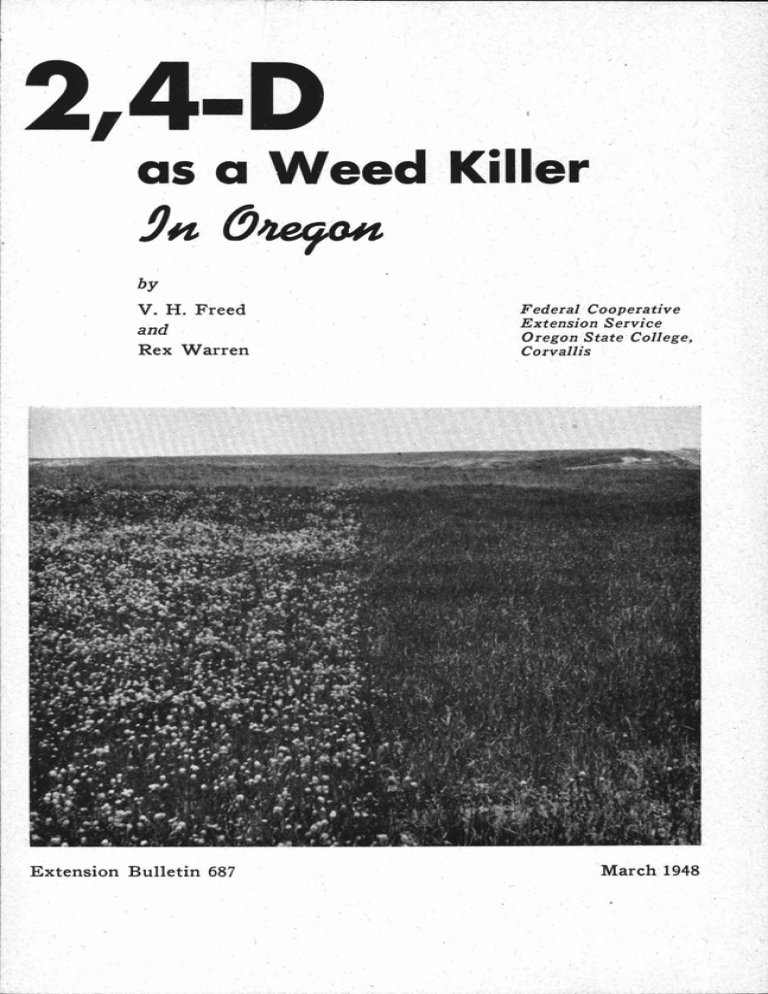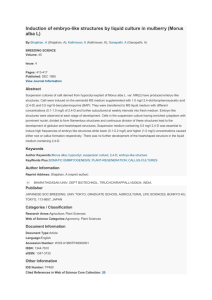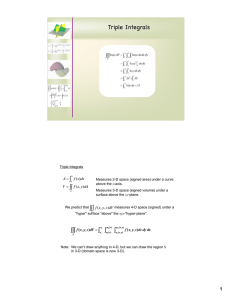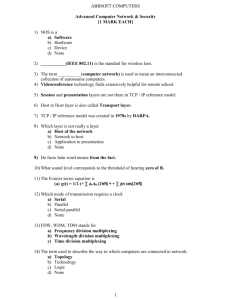2,4-D Weed Killer as a &erten
advertisement

2,4-D 1 as a Weed Killer 9frt &erten by V. H. Freed Federal Cooperative Extension Service Oregon State College, Corvallis and Rex Warren ' t t". . . , o.. ....;" _.,. *- ''' Or . 3..,,,,,... ..,:, 4* 4 7O.. .:e*ft 'Cr . 4 "P :. 40,... 411. a 44 ;:to... a Ad.... f 4 7**** . if ' . ' I.., S'IN !Qr.. " :1 4:: .n.. . 0. ,.". *. . 41 ' .s.,, .., a ..-4t4i. ' . ;L.:. --, ' -of ..*,.. b>j, * , ,,,. ..v.... ..,,, - .--1?-,*-40,1* ,.? ' .. , ..,,,.704, ,;."$* i:** . , ''4 '7 44;4 ,i, ), ; . p , -, at,,, 4 . 4....4.-%..1 ,..f....'11, . f. .. 4.6. tP ' 3 4 : ,,, ,111( * '' tit Extension Bulletin 687 p. ." -a° . i _01 'March 1948 2,4-D as a Weed Killer in Oregon Introduction The epoch-making discovery of the weed-killing power of growth-regulating chemicals such as 2,4-D has caused a revolution in agriculture. For the first time the farmer has a weapon with which he can obtain mastery over his weed enemies. No longer need he stand by helplessly while weeds voraciously consume water and plantfood elements needed by his crops. Today, when a grain or grass field is badly infested with weeds, the simple application of 2,4-D will eliminate most of them. This material is selective in its action, that is, it will destroy most plant enemies with little injury to grass and cereal crops if properly applied. Many acres of both grain and grass have been treated selectively with 2,4-D. Large areas of land have been treated for the control of perennial weeds. It has been estimated that upwards of one million acres in Oregon will be treated for weed control in 1948. This bulletin is written in light of the most recent information, but there are broad gaps in our knowledge of the use of these new and powerful herbicides. The reader is warned to use 2,4-D cautiously in situations for which there are no recommendations. In any event 2,4-D is not the ultimate solution to all of our weed ills. New practices and new chemicals are even now in the process of development to supplement and in some instances even supplant 2,4-D. 2,4-D The Chemical 2,4-Dichlorophenoxy acetic acid, which we abbreviate to 2,4-D, is a white, crystalline, organic acid. When pure, it resembles sugar in appearance. The pure material will not dissolve in water ; consequently it is necessary to treat it in manufacturing so that it may be soluble in water or so it will disperse in water. The 2,4-D is nonpoisonous to either man or livestock and is not corrosive when used according to direction. It is non-inflammable. Since the 2,4-D has to be treated to get it in usable form, certain derivatives are formed. The chemist thinks of a derivative as being the product of a reaction between the parent substance and some other material. Thus he might treat the 2,4-D acid and lye (sodium hydroxide) together to form the sodium salt derivative. Picture on cover An illustration of the effectiveness of 2,4-D On fanweed and mustard growing in winter wheat. Left, unsprayed; right, sprayed. 2 2,4-D AS A WEED KILLER 3 When two materials are mixed together, one of which is not active, it can readily be seen that the mixture, weight for weight, will not be equal to the "active" material. Rather it will contain a certain percentage or equivalents of the "active "material. So it is that when a derivative of 2,4-D is prepared we end up with a chemical mixture of 2,4-D that contains an equivalent of the original 2,4-D acid. The equivalent content of the mixture, weight for weight, will depend, of course, on the amount or weight of so-called inert ingredients added. Large numbers of derivatives of 2,4-D containing varying equivalents of the acid are on the market. Table 1 indicates the equivalents of some of the more common derivatives and their solubility and properties. Table 1: FORMULATIONS OF 2,4-D SHOWING MOLECULAR WEIGHT, AND EQUIVALENT, SOL- VENT AGENT AND STATE OF MATERIAL Per cent 2,4-D derivative 2,4-D acid Ammonium salt Sodium salt Sodium salt (monohydrate) Molecular weight 220 . 2,4-D acid or acid equivalent' Ethyl ester 242 260 325 369 307 248 93 91 85 68 60 72 89 Isopropyl ester 262 84 Diethanolamine salt Triethanolamine salt Morpholine salt Butyl ester Benzene , 237 276 L 80 State Dissolves in Alcohols, 100 Water Water Water Water Water Water Oils, but emulsifies in water Crystalline solid (powder) White powder Powder Liquid Liquid Liquid Liquid Oils, but emulsifies Liquid Oils, but emulsifies Liquid in water in water 'Acid equivalent has the same meaning in practical use as parent acid. AN AMINE SALT OF 2, 4 -D SOINLW SALT OF 2,4-D - AN ESTER OF 2,4-0 4 EXTENSION BULLETIN 687 By knowing the per cent by weight of a given 2,4-D derivative in a commerical herbicide, the 2,4-D equivalent content can be calculated by using the acid equivalent of the compound. Thus if a butyl ester of 2,4-D preparation weighs 8.25 pounds per gallon and contains 40 per cent of the active ingredient and we know that butyl ester has an acid equivalent of .8, it is possible to calculate the 2,4-D acid equivalent it contains : 825 X .40 X .8 = 2.64 pounds 2,4-D/gallon Pounds X per cent active ingredient = acid equivalent All materials sold in Oregon as economic poisons must be so labeled. The label will usually show the active ingredient, the percentage of this ingredient, and the weight or volume in the container. With the information from the label and from Table 1, the content of 2,4-D equivalent can be calculated. Effect on plants In killing a plant, 2,4-D acts in many respects more like a disease than a poison. It may take several weeks after treatment of 2,4-D before a plant dies. The first symptoms, which may appear a few hours after treatment, are twisting and bending of the stem and leaves. In some plants the above-ground portions may slowly turn brown until com- pletely dead ; others may remain green for a month or more but may become swollen, cracked, and may develop tumors or callus tissue. - Certain woody plants, when treated, change leaf color to red or yellow after which the leaves drop off. Roots of affected plants often develop tumorous regions ; the outer portions may slough off leaving a core that eventually decays. Unlike a disease, 2,4-D affects the plant most when it is young and growing vigorously. Thus if growing conditions are very favorable the 2,4-D will control the weeds more rapidly and completely than if conditions for growth are not so favorable. ' Application of 2,4-D Rate of application 2,4-D does not affect all plants in the same manner or to the same extent. Therefore certain crops may be treated with the chemical to destroy the weeds growing in them. The important factor in this selective action, aside from the plant species, is dosage or the amount of 2,4-D acid equivalent applied per acre. There are two broad classifications of 2,4-D applications ; they are : (1) selectively where it is desired to control weeds in a grow- 2,4-D AS A WEED KILLER 5 ing crop; and (2) nonselectively where it is desired to bring about the control of a given plant whether or not a crop is involved. The dosages required for the two different types of weed control differ in that in nonselective weed control a larger dosage of 2,4-D is used to get a better kill. It has been found that the simplest method of expressing dosage of 2,4-D is in pounds of 2,4-D acid equivalent per acre. All recommendations in this bulletin are based on this measure; thus, if it is stated that a treatment requires l pounds of 2,4-D per acre it means that 11 pounds of 2,4-D acid equivalent per acre should be used. Generally speaking, when making a selective application on grain or grass, to 1 pound of 2,4-D per acre is used. Where Canada thistle is the major weed, however, it may be desirable to use as much as 4 pounds of 2,4-D per acre. Nonselective weed control will usually require from 1 to 3 pounds of 2,4-D per acre. Methods of application 2,4-D may be applied in one of two ways : as a spray or as a : dust. For a given weight of 2,4-D the spray application is generally more effective than a dust application. We may apply 2,4-D as a spray in varying amounts of water per acre. A high-volume spray (50-100 gallons per acre) was first thought to be the way 2,4-D should be applied. It has been found that for selective spraying of grain and grass, low volumes (10 to 50 gallons per acre) of water are equally effective. A rule of thumb that will indicate whether to use low or high volume spray is : Use low volume spraying for selective weed con- trol and high volume spraying for control of perennial noxious weeds. The volume of water with which to apply the 2,4-D will depend on the spray machine to be used and the density of plant growth. The safest practice is to use enough water to insure uniform distribution of the 2,4-D and allow a margin of safety when the forward speed of the spray machine varies. Nearly any type of spray machine can be adapted to apply low volumes of spray. This may be done by using smaller nozzles, reducing the pressure, increasing the width of nozzle spacing, and increasing the speed. Pressure regulating valves may be purchased to fit practically all machines. With low volume spraying, pressures of 20 to 40 pounds per square inch are recommended. - 6 EXTENSION BULLETIN 687 Although much spraying is being done at less than 10 gallons per acre, there is good evidence that the best results are obtained from 10 gallons or more per acre. Development of new equipment may change this situation. The use of oils as carriers for 2,4-D in selective spraying is not recommended. There is more danger of injury to crop plants from 2,4-D-oil combinations than from 2,4-D-water combinations. Dusts of 2,4-D are available and may be used in place of sprays where water is a limiting factor. Since drift of dusts is hard to control, 2,4-D dust should not be used within two miles of any susceptible crops. It is recommended that dust be used only in the eastern Oregon wheat area or on range land where there is no possibility of drifts to susceptible crops. . 2,4-D dusts are not recommended for the Willamette Valley or other diversified crop areas. The most effective dust of 2,4-D for Oregon conditions is the ester dust. Ester dust is more effective than other types of 2,4-D dust wherever the humidity is low at the time of treatment. Generally, a slightly higher dosage will be needed when 2,4-D is used as a dust because the dust particles absorb some of the 2,4-D. The question arises as to how the 2,4-D is to be applied, by ground rig or airplane ? Each method has its advantages and disadvantages. Either method is about as effective for applying sprays and the cost is about the same. The airplane does not seem to be so good for applying 2,4-D dust as ground rigs, however. APPLICATION METHODS COMPARED Ground rigs Airplanes 1.- Cost about same as for airplane. Slightly slower than air. Cost about same as for ground rig. Faster than ground. Field must be dry. Can treat land before ground rigs Can't treat quite so early. Best for dust application. Better control of application. can get on it. Not recommended 2,4-D dust. for applying 2,4-D as a selective weed killer 2,4-D when used as a selective herbicide may be expected to give good results in controlling most broadleaf ed annual plants and taprooted perennial plants. The chemical may be used to control weeds in barley, wheat, oats, grass seed fields, grass pastures, and turf areas, including lawns. Crops such as alfalfa, clover, beets, 2,4-D AS A WEED KILLER 7 Figure 2. One of many types of sprayer rigs used for applying 2,4-D. onions, and peas should not be treated with 2,4-D because they are susceptible to the chemical. For a listing of crops and weeds showing their reaction to 2,4-D, see pages 15 and 16. For selective use the dosage rate will vary from to 1i pounds of acid equivalent per acre depending on conditions and on the kind of weed. The lower rates are usually used on grain for control of young, annual broadleaf plants. The higher rate will be used on established grass plantings or on grain for control of perennial weeds or hard-to-kill annuals. Generally the salts will be used at the higher dosages and esters at lower dosages. Figure 3. Spraying 2,4-D with airplanes is practical on large fields. EXTENSION BULLETIN 687 8 Formulations of 2,4-D Three different formulations of 2,4-D are available to the user : 2,4-D acid. Usually dissolved in a material like polyethylene glycol, which is similar to antifreeze for a car, to make it readily dispersible in water. Salts of 2,4-D. These may be in powdered form such as the sodium salt or in liquid form. Both are used in commercial preparations. Esters. Derivatives of 2,4-D resulting from the reaction between 2,4-D acid and an alcohol. The common esters are liquids. They will dissolve in oil and by proper formulation may be made to disperse in water. Most of the common commercial ester formulations are liquids that disperse in water. Esters are also available as dusts. Often the question is asked "How can I tell the difference between an ester and a liquid salt?" The easiest method of telling them apart is by means of their appearance in water. Place a few drops of the liquid in a small jar of water and shake. If the solution is clear even though it may be colored the material is a salt. If the water turns milky the product is an ester. There appears to be little difference in the relative effectiveness of these three products when used on a comparable acid equivalent basis under ideal conditions. Under less favorable conditions and on resistant, hard-to-wet or brushy plants the esters appear to be more effective. This is probably due to their better penetration and wetting properties. There are indications that the rapid action of the esters is not always the most effective. For example, when morning-glory is growing under favorable conditions, other formulations often give superior control. When to apply 2,4-D - The time to apply 2,4-D as a selective spray will depend on the stage of growth of both the weed and the crop. Generally, the younger the weed the more effective the treatment. Grain may be treated when it is 6 to 8 inches high or when 0 it begins to stool. In any event, it should be treated before it emerges from the "boot." Grass for seed should be sprayed before it gets out of the "boot." Lawns and turfs are best treated in the spring or fall but can be treated effectively during the summer months. - 2,4-D AS A WEED KILLER 9 Since injury to grain or grass is always a possibility, the correct amount of 2,4-D must be applied. It cannot safely be reasoned that because a little 2,4-D does some good more of it should do better. Too heavy an application will not necessarily increase the yield over untreated fields. The term "selectivity" of 2,4-D is only relative and even resistant crops are affected by the chemical. For example in grain, if there are no weeds in the crop a treatment of 2,4-D will lower the yield by a bushel or two per acre. With as few as 2 or 3 weeds per square foot, however, a treatment with 2,4-D will increase the yield significantly over untreated grain. By the proper use of 2,4-D, yields of grain have been increased as much as 50 to 100 per cent over untreated fields. 2,4-D for control of perennial weeds 2,4-D is an economical and convenient material for aiding in the control of some perennial noxious weeds. But it is not a wonder chemical that will bring about complete eradication of these plants with one application. Control of perennial weeds, especially creeping plants such as morning-glory and Canada thistle, will come only after repeated application of the chemical. It appears that one of the most effective and economical methods of controlling perennial noxious weeds is to grow a suitable grain or grass crop and use 2,4-D. The 2,4-D causes a partial destruction of the weed plant and the crop tends to hold the remaining plants down by competing with them for food and water. The crop, either grain or grass, should be selected to fit into the general crop program. Vigorous growing grass crops such as Alta fescue in western Oregon or crested wheatgrass in eastern Oregon usually provide more competition than the grain crops. The chemical should be applied as a selective spray in the spring at to 1 pound of 2,4-D acid equivalent per acre. Another heavier application should be made after harvest and when weeds have made appreciable growth. This later application is an important ste'p in effective control. The usual rate of application for nonselective weed control is from 1 to 3 pounds of 2,4-D acid equivalent per acre. The amount to use will depend on the species of plant, the stage of growth, and the growing conditions. in general, heavier applications are needed as the plant gets older. The amount of water with which to apply the 2,4-D will vary with the amount of growth and the spray rig to be used. An excess EXTENSION BULLETIN 687 10 of water to insure- uniform and thorough coverage is better than too little water. The formulation of 2,4-D to use will Vary with the plant and, stage of growth. Esters of 2,4-D have shown considerable promise on perennial plants but 'there are exceptions to this. In general, the esters are recommended on brushy plants, hard-to:wet plants and mature plants. Where the plants are difficult to wet, the incorporation of diesel or fuel oil in the spray mixture is often helpful. Four or five gallons of oil in 100 gallons of spray mixture greatly facilitates wetting. As a rule, perennial weeds are most readily' controlled by 2,4-D * when treated at early stages of growth. For example, whitetop, St. John's wort, and tansy ragwort are much more readily controlled in the rosette stage than at later stages of growth. Some plants, on the other hand, even though more susceptible at younger stages, do not 'have a large enough leaf surface to permit entry of enough 2,4-D. These plants must be allowed to develop larger leaf surfaces before treating. Treatment of morning-glory and Canada thistle, for example, is more effective if the plants Are allowed to reach the pre- bloom stage.; Water weed control , , The control of Weeds in irrigation and drainage ditches, lakes and streams is becoming more important. 2,4-D offers a good deal of hope in controlling these particular plants. But this chemical is not a panacea. There are many aquatic plants which it apparently will not control ; also there is some danger in its use, particularly in irrigation ditches. Great care must be taken' to prevent water contaminated by 2,4-D from coming in contact with crop plants. If a drainage ditch or its banks are to be treated for weed control it should be done at the season of the year when the ditch is not in use. If this practice is impossible, the water should be "wasted" for 24 to 48 hours after application in order to avoid crop injury. If much of the ditch is to be treated, the water in the entire system below the treated area should be "wasted." The ester formulation of 2,4-D appears to be peculiarly well suited for aquatic Weed control. This applies both to the weeds growing in the ditches such as pondweed and those along the edge such as cattails and tules, I Other weed killers 41 , 2,4-D is not the only. growth-regulating chemical for weed control. Several new chemicals similar in their behavior are being in- - 2,4-D AS A WEED KILLER 11 vestigated at the present time. Some of them will supplement 2,4-D in that they will control plants resistant to 2,4-D. Others will have specialized uses on particular crops and weeds. It is still too early to indicate the uses of materials such as 245-T - or MCPA. Whatever the plants that are to treated, the same techniques of application and approximately the same dosages as used with 2,4-D will probably apply to these new chemicals. Suggested Practices Brushy Plants 1. Best results are obtained if sprayed early in spring after plant has fully leafed out. 2. Suggested spray formula : 2 to 3 pounds 2,4-D acid equivalent as ester. 5 gallons of diesel oil. Mix oil and 2,4-D together and add to water. The addition of wetting and spreading agents may be helpful. 95 gallons of water. Spray plants until thoroughly wet. 3. Re-treat as necessary. Floating Water Weeds Spray the surface with 2,4-D at the rate of 14- to 2 pounds per acre. Submerged Water Weeds Plants, such as parrot feather, coontail, and pondweed require a concentration of approximately 10 parts per million for control. This corresponds to 27.2 pounds of 2,4-D for 43,560 cubic feet of water or 1 acre foot. - Canada Thistle In grain or grass Spray while crop is in "boot." Use 1 to 11 pounds of 2,4-D acid equivalent per acre. Following harvest, make a second application of 2,4-D at to 3 pounds per acre as thistle reaches a height of 12 to 18 inches. For control of Canada thistle, it is recommended that the area be seeded down to grass or as a second choice, grain, and given two sprays per year. Two years of treatment will bring about a real reduction in the stand of thistle. - EXTENSION BULLETIN 687 12 On noncrop land Leave plants undisturbed in spring. Apply 1+ to 3 pounds 2,4-D acid equivalent per acre. Apply 2,4-D when thistle is beginning to form flower buds (12 to 18 inches high). Make retreatment as often as thistle makes regrowth. Morning-Glory On crop land Plant spring grain or grass. 2. Spray while crop is in late tiller stage. 3., Use to 1 pound 2,4-D acid equivalent. Make a second application of 2,4-D in the fall after harvest if morning-glory makes any regrowth. If rotation is alternate crop-fallow make application in fallow in June or July., The land should not be cultivated before treating other than to be plowed and worked down. On noncrop land Leave land undisturbed in spring. (One shallow cultivation sometimes brings about a more uniform emergence.) Apply 1 to 1+ pounds of 2,4-D acid equivalent in sufficient water (or dust) to get uniform coverage. Apply 2,4-D about the time the first flowers are noticeable. Application to small plant with insufficient leaf area does not permit entrance of sufficient 2,4-D to effect a satisfactory kill. 4.. There is some indication that the salts of 2,4-D are best for morning-glory. Under dry conditions or when temperatures are low, esters of 2,4-D may be preferred. / Figure 4. Plantain on left was treated with 2,4-D one week before this picture was taken. Untreated plantain on right. 2,4-D AS A WEED KILLER 13 Spot Spraying Resistant, hard to wet plants 1. 2.. 2,4-D ester equal to 2 or 3 pounds acid equivalent. Oil may be added if desired (5 gallons). 95 to 100 gallons of water. Formulation of hand sprayer use: a. b. to 2 ounces 2,4-D acid equivalent (about per cent ester preparation). 3. gallons of water. teacup of a 40-50 1 Susceptible plants 2,4-D equal to 1i to 2 pounds acid equivalent. 100 gallons of water. Cattail and tule Allow to attain full growth. 2. The following spray is suggeSted 1. Ester of 2,4-D equal to 2 to 4 pounds acid equivalent. 5 gallons of diesel oil. Add 2,4-D to oil and then mix with water. 95 gallons of water. - Lawns and turfs Use 5-16 ounce of 2,4-D acid equivalent per 1,000 square feet. (1 pound per acre). Use enough water to insure uniform coverage (1 to 2 gallons per thousand feet). Do not mow for 2 days before treatment or 2 days after treatment. Wild Garlic (These recommendations are tentative and are based on one season's work.) In grain or grass crop 1. Make early spring application (March, April) when garlic is 5" to 8" high. 2. Apply 2,4-D in ester form at rate of to 1 pound acid equivalent per acre. 3. Suggested spray formula : to 1 pound parent acid of 2,4-1) as ester. 2 gallons of diesel oil. Mix oil and 2,4-D together and add to water. 50 gallons of water. - Apply at rate of 50 gallons per acre. Wetting and spreading agents are helpful in wetting the garlic. 4. Spray in fall if there is moisture enough to bring about regrowth. EXTENSION BULLETIN 687 14 2,4-D as a preemergent treatment Preemergent treatments are treatments applied after a crop is planted but before it begins to grow. 2,4-D has been publicized for this purpose, particularly on corn. 2,4-D cannot be used for a preemergent spray on any susceptible crop (see list at back of this bulletin). Even on crops tolerant of 2,4-D, such as corn, the dosage must not be excessive. A rate of one pound per acre of 2,4-D is enough. Preplanting treatments are often made in lieu of preemergent treatments. This treatment necessitates an early seedbed preparation. If susceptible crops are to be planted, the treatment must be made at least six weeks ahead of planting. Preemergent treating is a new practice. There is still much to be learned about it. Trials are under way at Oregon State College to get more information on this subject. Precautions 2,4-D is difficult to remove from spray equipment. It must be removed before spraying with other material or injury or killing of other crops may result from even a trace of 2,4-D. To clean a sprayer thoroughly : a. Rinse with fresh water several times, flushing it through the pump and hoses. b. Fill the tank with water and add 1 pound of lye, soda ash, or sal soda for each 100 to 150 gallons of water and let it stand overnight. Start pump and circulate solution for a few minutes; a. then pump out. Rinse with 2 or 3 washes of clean water. Control spray or dust drifts. Small amounts of 2,4-D can injure or kill susceptible crops. Since dust drift is hard to control do not use dust in diversified crop areas. Application of as little as 1 pound of 2,4-D per acre may cause temporary soil sterility. Treating of fields with 2,4-D should be done a month to six weeks before planting. Some crops such as vetch, clover, sugar beets, and tomatoes are very sensitive to even small amounts of 2,4-D. 2,4-D treatments may cause abnormalities in the plant if not applied at the proper time. These abnormalities may take the form of reduced germination, blank heads or undeveloped ears of corn. 2,4-D AS A WEED KILLER 15 The vapors or fumes from esters and certain other 2,4-D derivatives may cause injury to susceptible plants if used too near them. Proper application of 2,4-D is important. Calibrate equipment to do the job. Avoid both excessive dosage and too light dosage. Table 2. RECOMMENDED DOSAGES OF 2,4-D ACID EQUIVALENT FOR DIFFERENT CROPS To control Crop Grains annual weeds To control perennial weeds Pounds per acre Pounds per acre h-1 i-1 Time to apply Remarks Late tillering or early - Early treatment When corn is 8" or higher "Boot" stage Apply when 6-10" high Salts of 2,4-D only "boot" Seedling grass Corn it 1 Grass (old stands) i-1 1-11 Seed flax$ I Orchards§ .1 Lawns 1 (5/6,oz. to Spring and - Use only sodium salt of 2,4-D Use only sodium salt. Extreme care necessary. summer 1,000 sq. ft.) Spray should be directed toward base of corn ,plant. t Preemergent treatment may be recommended after another year's trial. $ 2,4-D cannot be used on fiber flax. § Avoid contact of trees with material. Lowest branches should be 4 feet above ground. Crops Susceptible to 2,4-D Vetch Sweet clover Peas Clovers Alfalfa Fiber Flax Strawberries Cane berries Orchard trees Ornamental Shrubs Mint - Onions Beets Spinach Squash Cucumbers Pumpkin Tomatoes Cabbage Cauliflower Flowers EXTENSION BULLETIN 687 16 Susceptibility of Plants to 2,4-D A susceptible plant is one that will be killed by one application of 2,4-D. An intermediate plant is one that will require more than one application. A resistant plant is unaffected by 2,4-D. Alder Susceptible Poison Oak Pigweed Plantain Poison Hemlock Puncture Vine Blackmedic Bull thistle Burdock Buttercup Cottonwood Chicory Cockleburr Russian Thistle (young) Shepherds Purse Sow thistle (annual) Star thistle (yellow) Cat's-ear (False dandelion) Dandelion Fanweed, scaleweed, peppergrass Hairy Vetch Heal-all Lambs quarter Lawn pennywort Mustards Nettles Skunk Cabbage Sweet clover Tumble weed Water hemlock Wild carrot Wild Willow Wild radish Poplar. Intermediate Bachelor button (French Pink) Boxelder Cattail Canada thistle Dock Dogwood Fiddleneck Gooseberry Knotweed Mallow Perennial Dogbane Smartweed Sherrardia Speedwell St. John's wort (Klamath weed) Sage Teasel Tules Tansy ragwort Tussocks - White top Wild Garlic Resistant Alkali mallow Annual bluegrass Blackberry Brackenf ern Button willow Crabgrass Goldenrod Horsetail rush Maple Milkweed Oak Oxalis Quackgrass Russian Knapweed Sandbur Watergrass Wild Barley Wild oats Wild Rose Yarrow Cooperative Extension Work in Agriculture and Home Economics Wm. A. Schoenfeld, Director Oregon State College and United States Department of Agriculture, Cooperating Printed and distributed in furtherance of the Acts of Congress of May 8 and June 30, 1914




